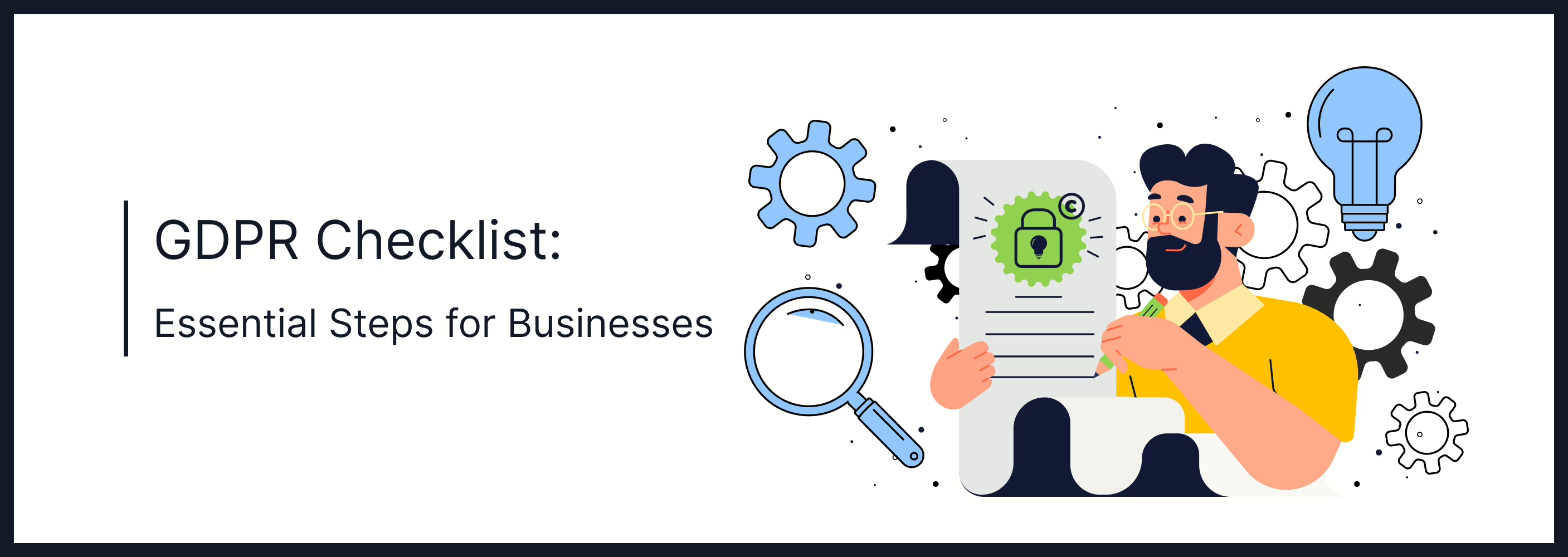
Oct 15, 2024 Information hub
GDPR Checklist: Essential Steps for Businesses to Ensure Data Protection Compliance
In today’s digital age, data privacy has become a critical concern for businesses and individuals alike. With the increasing amount of personal data being collected, stored, and processed, the need for stringent regulations to protect this data has never been more important. Enter the General Data Protection Regulation (GDPR)—a landmark piece of legislation that has reshaped how organizations handle personal data. Since its enforcement in May 2018, GDPR has set the standard for data protection laws worldwide, and non-compliance can lead to hefty fines and reputational damage. For businesses operating in or dealing with the European Union (EU), adhering to GDPR is not optional. However, navigating the complexities of GDPR can be daunting, especially for small and medium-sized enterprises (SMEs). This is where a GDPR checklist comes in handy. A well-structured checklist ensures that your organization is compliant with GDPR requirements, minimizing the risk of penalties and safeguarding your customers’ data.
In this blog post, we will provide a comprehensive GDPR checklist, breaking down the essential steps your business needs to follow to ensure compliance. We will also explore the relevance of GDPR today, practical examples, current trends, challenges, GDPR checklist, and future developments in data protection.
The Relevance of GDPR Today
Why GDPR Still Matters
Although GDPR was introduced in 2018, its relevance has only grown in the years since. With the rise of digital transformation, businesses are collecting more personal data than ever before. Whether it’s through e-commerce platforms, social media, or mobile apps, personal data is the new currency of the digital economy. However, with this increased data collection comes greater responsibility.
GDPR is not just a legal requirement; it is a framework that promotes transparency, accountability, and trust between businesses and their customers. In an era where data breaches and cyberattacks are becoming more frequent, GDPR compliance is essential for maintaining customer confidence and avoiding legal repercussions.
Statistics on GDPR Enforcement
To understand the importance of GDPR compliance, consider the following statistics:
- Since its enforcement, GDPR has led to over €1.5 billion in fines across the EU.
- In 2021 alone, the number of GDPR fines increased by 113% compared to the previous year.
- The largest GDPR fine to date was imposed on Amazon, amounting to €746 million for non-compliance.
These figures highlight the financial risks associated with non-compliance, making it clear that businesses cannot afford to ignore GDPR.
GDPR Checklist: Key Steps to Ensure Compliance
1. Understand the Scope of GDPR
Before diving into the specifics of compliance, it’s crucial to understand whether GDPR applies to your business. GDPR applies to:
- Businesses operating within the EU: If your company is based in the EU, GDPR applies to you, regardless of the size of your business.
- Businesses outside the EU: If you offer goods or services to individuals in the EU or monitor their behavior, GDPR applies to you, even if your business is located outside the EU.
Key Questions to Ask:
- Do we collect or process personal data of EU citizens?
- Do we offer goods or services to EU residents?
- Do we monitor the behavior of individuals within the EU?
2. Appoint a Data Protection Officer (DPO)
Under GDPR, certain organizations are required to appoint a Data Protection Officer (DPO). The DPO is responsible for overseeing data protection strategies and ensuring compliance with GDPR.
When is a DPO Required?
- If your organization processes large amounts of personal data.
- If your core activities involve regular and systematic monitoring of individuals.
- If you process special categories of data (e.g., health data, biometric data).
Responsibilities of a DPO:
- Informing and advising the organization on GDPR obligations.
- Monitoring compliance with GDPR.
- Acting as a point of contact for data subjects and supervisory authorities.
3. Conduct a Data Audit
A data audit is a critical step in understanding what personal data your organization collects, how it is processed, and where it is stored. This audit will help you identify potential risks and areas where GDPR compliance may be lacking.
Steps to Conduct a Data Audit:
- Identify the types of personal data you collect (e.g., names, email addresses, IP addresses).
- Map out data flows to understand how data moves through your organization.
- Review third-party processors to ensure they are GDPR-compliant.
- Document your findings to create a clear record of your data processing activities.
4. Obtain Lawful Consent
One of the core principles of GDPR is that personal data must be processed lawfully, fairly, and transparently. In many cases, this means obtaining explicit consent from individuals before collecting or processing their data.
Key Requirements for Consent:
- Consent must be freely given, specific, informed, and unambiguous.
- Individuals must be able to withdraw consent at any time.
- Consent requests must be separate from other terms and conditions and written in clear, plain language.
Practical Example:
A retail company that collects email addresses for marketing purposes must ensure that customers explicitly opt-in to receive marketing communications. Pre-ticked boxes or implied consent are not acceptable under GDPR.
5. Implement Data Subject Rights
GDPR grants individuals several rights regarding their personal data, and businesses must have processes in place to honor these rights.
Key Data Subject Rights:
- Right to Access: Individuals can request access to their personal data.
- Right to Rectification: Individuals can request corrections to inaccurate data.
- Right to Erasure: Also known as the “right to be forgotten,” individuals can request the deletion of their data.
- Right to Data Portability: Individuals can request their data in a structured, commonly used format.
- Right to Object: Individuals can object to the processing of their data for certain purposes, such as direct marketing.
Actionable Steps:
- Set up a process for handling data subject requests.
- Ensure that requests are responded to within the GDPR-mandated timeframe (typically one month).
- Train staff on how to recognize and respond to data subject requests.
6. Ensure Data Security
GDPR requires businesses to implement appropriate technical and organizational measures to protect personal data from unauthorized access, loss, or destruction.
Key Security Measures:
- Encryption: Encrypt personal data to protect it from unauthorized access.
- Access Controls: Limit access to personal data to only those employees who need it for their job.
- Regular Security Audits: Conduct regular audits to identify and address vulnerabilities.
- Incident Response Plan: Develop a plan for responding to data breaches, including notifying affected individuals and the relevant supervisory authority.
Case Study:
In 2020, British Airways was fined £20 million for failing to protect the personal data of over 400,000 customers. The breach occurred due to inadequate security measures, highlighting the importance of robust data protection practices.
7. Review Contracts with Third-Party Processors
If your organization uses third-party processors to handle personal data (e.g., cloud service providers, marketing agencies), you must ensure that these processors are GDPR-compliant.
Key Considerations:
- Data Processing Agreements (DPAs): Ensure that you have a DPA in place with all third-party processors. This agreement should outline the processor’s responsibilities and obligations under GDPR.
- Due Diligence: Conduct due diligence to verify that third-party processors have adequate security measures in place.
8. Prepare for Data Breaches
Under GDPR, businesses are required to report certain types of data breaches to the relevant supervisory authority within 72 hours of becoming aware of the breach. If the breach poses a high risk to individuals’ rights and freedoms, affected individuals must also be notified.
Steps to Prepare for a Data Breach:
- Develop a Data Breach Response Plan: Outline the steps your organization will take in the event of a breach.
- Train Employees: Ensure that employees are aware of the procedures for reporting and responding to data breaches.
- Conduct Regular Drills: Test your data breach response plan to ensure it is effective.
Current Trends, Challenges, and Future Developments
Trends in GDPR Compliance
- Increased Focus on Data Minimization: Businesses are increasingly adopting data minimization practices, collecting only the data they need and retaining it for the shortest time possible.
- Automation of Compliance: Many organizations are turning to automated tools to help manage GDPR compliance, from consent management platforms to data mapping software.
- Cross-Border Data Transfers: With the invalidation of the EU-US Privacy Shield, businesses are facing new challenges in transferring data outside the EU. The use of Standard Contractual Clauses (SCCs) has become more prevalent.
Challenges in GDPR Compliance
- Complexity for SMEs: Small and medium-sized businesses often struggle with the complexity of GDPR, particularly when it comes to appointing a DPO and conducting data audits.
- Evolving Regulatory Landscape: As data protection laws continue to evolve, businesses must stay up-to-date with new regulations and guidance from supervisory authorities.
Future Developments
- AI and Data Privacy: As artificial intelligence (AI) becomes more integrated into business operations, new challenges around data privacy and GDPR compliance are emerging. Future updates to GDPR may address the unique privacy concerns posed by AI.
- Global Influence of GDPR: GDPR has set a global standard for data protection, and many countries are adopting similar regulations. For example, Brazil’s Lei Geral de Proteção de Dados (LGPD) and California’s Consumer Privacy Act (CCPA) are heavily influenced by GDPR.
Conclusion
GDPR compliance is not just a legal obligation; it is a critical component of building trust with your customers and protecting their personal data. By following the steps outlined in this GDPR checklist, your organization can ensure that it meets the requirements of GDPR and avoids the costly penalties associated with non-compliance.
Actionable Takeaways:
- Conduct a thorough data audit to understand what personal data you collect and how it is processed.
- Appoint a Data Protection Officer (DPO) if required.
- Obtain explicit consent from individuals before processing their data.
- Implement robust security measures to protect personal data.
- Prepare for data breaches by developing a response plan and training employees.
By taking these steps, your business will be well on its way to achieving GDPR compliance and safeguarding the personal data of your customers.
By following this GDPR checklist, businesses can navigate the complexities of data protection and ensure they remain compliant in an ever-evolving digital landscape.
